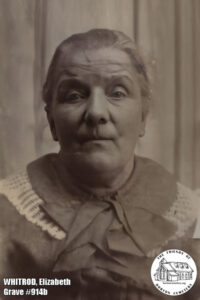b.1849-d.1910
Mary Ann Swain was born in the City of London on 18th July 1849 and baptised at St Martin in the Fields, Westminster on 2nd September 1849.
Her father, Thomas Randall Swain, was a marble paper maker, a skilled craftsman, who was given Freedom to the City of London in 1856. His family appear to have been shopkeepers from London and her mother’s side were saddlers. Her mother was Harriet Cuss.
The family were living at Bread Street Hill, in the heart of the City of London when Mary was born. Her father’s profession suggests the family wouldn’t have been poor.
1850s
In the 1851 census Mary Ann was with her family. They were now living at St Nicolas Olave Church Yard, in a house adjacent to the rectory, but still in the City of London. She appeared to have an older sister Ellen Emma who was 7 and a brother, also called Thomas Randall, aged 3. Her father’s birth place was Westminster; her mother’s was St Martins in the Field.
The Land Tax Records for 1853 show the house was rented from a Miss Charlesworth for 2/9d.

1860s
In the 1861 census, the family was still in St Nicholas Olave. Mary was 11 years old and at school. She now had three younger siblings; Elizabeth age 9, Harriet age 7 and Alfred age 3.
They were also born in the City of London.
Her father Thomas Randall Swain was now a book edge marbler, which we presume might have been a promotion. The two eldest siblings, Ellen and Thomas, were both shown as marblers of paper. Perhaps they were helping their father in a family business?
1870s
By 1871, it appeared that Mary had found work as a barmaid in the next street, at number 13 Bread Street Hill. This was the site of the Horse and Dorsers pub.
The head of the premises was a licensed victualler called Thomas Brinn from Wales. She was 21 years old by then. Could this have been where she met her future husband?
On the 2nd June 1878, when she was 29, Mary married Alfred George Oram, a fellow Londoner, at the parish church of St Martin in the Fields. Alfred was a waiter and his father, James Oram, was a jeweller. The address for both Alfred and Mary at the time was 23 Cecil Court, which is a street in Covent Garden linking Charing Cross and St Martin’s Lane.
Children
In 1879, Mary gave birth to her first child, a son, Alfred John. The birth was registered in the Strand district in the Sept qtr. Alfred had been baptised a few weeks earlier on August 10th 1879, at Christ Church, Clapton, which was part of Hackney in East London.
Her husband was still making a living as a waiter and their address was 15 Catherine Street in the Strand. (This property still exists – https://historicengland.org.uk/listing/the-list/list-entry/1209861 ). Catherine Street was part of London’s theatreland, as it is today and there were plenty of restaurants and bars in the area, where Alfred may have worked.
1881 census
By 1881, Mary and Alfred had moved south of the river (Thames) to Lambeth, to 38 Olney Street, Newington, with their son Alfred. They were sharing number 38 with another couple. Some of the other houses in the street were also shared by two families. This area seemed to be skilled working class eg. tradesmen or clerks.
Alfred was still working as a waiter and Mary Ann was at home with Alfred who was now one. Her age on the census is given as 28 but in reality, she would have been 31 whereas Alfred’s age at 26 was correct.
Almost four years later, on 20th November 1884, Mary gave birth to a daughter, Alice Maud Oram. The birth was registered in 1884, Dec qtr, in Camberwell
1891 census
By 1891, they were living at a different address, number 18, Faraday Street but still in Newington. The Oram family occupied three rooms in the house, and shared it with two other families. This multiple occupancy was normal for a lot of working families at the time. It appeared they weren’t in for the census enumerator however, as “out” has been recorded under ‘where born’, so we have no further details.
Alfred is still listed as a waiter and Mary didn’t have an occupation as was the case for most married women at that time. The children were at school. Alfred is 11 and their daughter Alice Maud is 6 .
1901
By 1901 Mary and her family have moved again. They are now at 29 Sedan Street, but still in Newington. Their daughter Alice Maud now seems to be following in her father’s footsteps and has employment as a waitress.
Just a short time later, on 12 June 1901 when she was 51, we find Mary appearing in a workhouse record for the first time, when she was admitted to Newington Workhouse, Westmoreland Road. The record states she is married, a Baptist, (was this correct?) and in the observations section, it is written “all of lunatic”. Under ‘parish from which admitted’ it states “new” which I expect means Newington. What could have brought this on?
On the 21 June 1901 she was discharged from Newington Workhouse, Westmoreland Road to Manor Asylum Epsom. Mary doesn’t have a history of being admitted to the workhouse or previous stays at asylums. Was it some kind of mid-life crisis?
She was never discharged and spent the rest of her life at Manor Asylum, dying nine years later on 16th September 1910 when she was 61. Mary was buried in plot 861b in Horton Cemetery on 23rd September.
After Mary
Seven months later at the date of the 1911 census, her husband was living in just one room in 92 Carter Street, Walworth. He was now a vegetable cook in a hotel and no longer a waiter – a demotion. The census confirms there were just the two children.
Times must have been hard for him though, as in 1914, he admitted himself to the workhouse in Renfrew Road. A lonely man with no one to care for him, without a job by then and a widower. The tragedy of the asylum affected those left behind.
Children
Alfred John marries Lucy Ann Harvey in 1903 and went on to fight in WW1. He stayed in London and died in Lambeth in 1965.
Alice Maud married Ebenezer Harvey in 1907. He was most likely the brother of Lucy Ann Harvey, her sister in law, as someone of the same name is listed on Alfred’s marriage certificate. Ebenezer was a French polisher. She died in Lambeth as well, in 1963.
Alice seems to have had some stints in workhouses, being admitted with her four children in 1915 to the same workhouse as her mother – Newington, Westmoreland Road
Author’s comments.
Mary appears to have had a stable background without poverty or the early death of close family members. There is no history of previous admissions to the workhouse or the asylum either. Something went wrong in her middle age. Could it have been depression brought on by menopause or something else?




